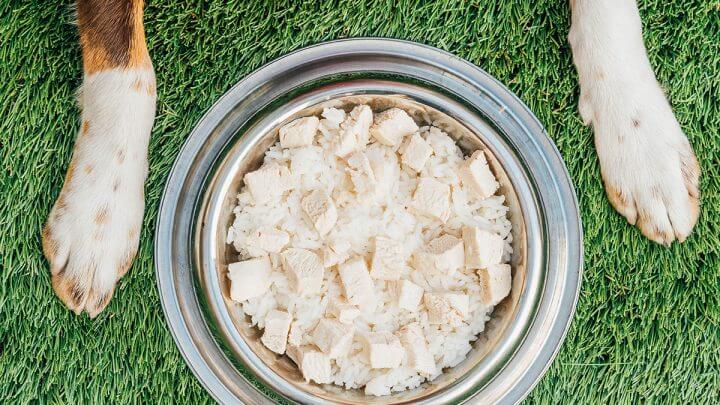
Introduction
When our furry companions aren’t feeling their best, it can be a cause for concern. Upset stomachs in dogs are a common issue, often arising from dietary indiscretions or mild illnesses. In such cases, the BRAT diet, originally designed for humans, can be adapted to provide relief for our canine friends. In this article, we’ll explore the benefits and considerations of the BRAT diet for dogs.
Table of Contents
- Understanding the BRAT Diet
- What does “BRAT” stand for?
- Origins in Human Medicine
- Adapting for Canine Use
- Why Consider the BRAT Diet for Dogs?
- Gentle on the Digestive System
- Balanced Nutritional Components
- Reduces Stress on the GI Tract
- Ingredients of the BRAT Diet
- Bananas: Nature’s Digestive Aid
- Rice: A Soothing Staple
- Applesauce: Nutrient-Rich and Easily Digestible
- Toast: Providing Sustenance
- How to Prepare BRAT for Dogs
- Cooking Methods and Considerations
- Serving Sizes and Frequency
- Transitioning In and Out of the Diet
- Monitoring Your Dog’s Progress
- Signs of Improvement
- When to Seek Veterinary Advice
- Variations and Additional Considerations
- Alternatives to the BRAT Diet
- Special Cases and Dietary Restrictions
- FAQs – Addressing Common Concerns
- Can I continue my dog’s regular diet alongside the BRAT diet?
- How long should I keep my dog on the BRAT diet?
- Are there any risks associated with the BRAT diet for dogs?
- Can I add supplements to the BRAT diet?
- What if my dog refuses to eat the BRAT diet?
Understanding the BRAT Diet
What does “BRAT” stand for?
The term “BRAT” is an acronym that stands for Bananas, Rice, Applesauce, and Toast. Originally, this diet was developed for humans experiencing digestive upset.
Origins in Human Medicine
The BRAT diet gained popularity due to its gentle nature on the digestive system. It consists of bland, easily digestible foods that provide essential nutrients without causing further irritation.
Adapting for Canine Use
While dogs have different nutritional needs than humans, the principles of the BRAT diet can be applied to support their digestive health. Adapting the BRAT diet for dogs involves selecting ingredients that align with their dietary requirements.
Why Consider the BRAT Diet for Dogs?
Gentle on the Digestive System
The BRAT diet’s simplicity and mild components make it a suitable option for dogs with sensitive stomachs. It helps soothe irritation and allows the gastrointestinal tract to recover.
Balanced Nutritional Components
Bananas, rice, applesauce, and toast offer a combination of carbohydrates, fiber, vitamins, and minerals. These elements contribute to a well-rounded and easily digestible diet for dogs on the road to recovery.
Reduces Stress on the GI Tract
The BRAT diet minimizes the workload on the digestive system, giving it a chance to heal. This can be especially beneficial for dogs experiencing temporary gastrointestinal issues.
Ingredients of the BRAT Diet
Bananas: Nature’s Digestive Aid
Rich in potassium, fiber, and essential vitamins, bananas provide a natural way to regulate digestion. They are easy on the stomach and can help replenish lost nutrients.
Rice: A Soothing Staple
Plain, cooked white rice is a staple in the BRAT diet. It’s gentle on the digestive system and acts as a binding agent, helping to firm up loose stools.
Applesauce: Nutrient-Rich and Easily Digestible
Unsweetened applesauce offers a range of vitamins and antioxidants. It’s soft on the stomach and can provide necessary hydration.
Toast: Providing Sustenance
Lightly toasted bread can be a source of carbohydrates and fiber. It’s easily digestible and can be a comforting addition to the diet.
How to Prepare BRAT for Dogs
Cooking Methods and Considerations
When preparing the BRAT diet for dogs, it’s important to use plain, unseasoned ingredients. Avoid adding any spices, salts, or sugars.
Serving Sizes and Frequency
The serving size will depend on the size and appetite of your dog. Start with small portions and monitor their response. Offer frequent but small meals throughout the day.
Transitioning In and Out of the Diet
Gradually introduce the BRAT diet by mixing it with your dog’s regular food. Similarly, when transitioning back to their regular diet, do so slowly to avoid upsetting their stomach.
Monitoring Your Dog’s Progress
Signs of Improvement
Watch for positive changes in your dog’s behavior, energy levels, and stool consistency. These are indicators that the BRAT diet is having a beneficial effect.
When to Seek Veterinary Advice
If your dog’s condition doesn’t improve after a day or two on the BRAT diet, or if it worsens, consult your veterinarian for further guidance.
Variations and Additional Considerations
Alternatives to the BRAT Diet
While the BRAT diet is gentle and effective for many dogs, some may require alternative approaches. Consult your vet for tailored advice based on your dog’s specific needs.
Special Cases and Dietary Restrictions
Dogs with certain health conditions or dietary restrictions may require modifications to the BRAT diet. Always consider your dog’s individual circumstances.
Conclusion
The BRAT diet for dogs offers a gentle and effective way to address upset stomachs. By providing easily digestible, nutrient-rich foods, you can help your furry friend on the path to recovery.
FAQs – Addressing Common Concerns
Can I continue my dog’s regular diet alongside the BRAT diet?
Yes, you can gradually reintroduce their regular diet once their stomach begins to settle. Monitor their response and adjust as needed.
How long should I keep my dog on the BRAT diet?
Continue the BRAT diet until you see signs of improvement, usually for 24 to 48 hours. Consult your vet if there’s no positive change.
Are there any risks associated with the BRAT diet for dogs?
The BRAT diet is generally safe for short-term use. However, if used for an extended period, it may lack certain nutrients. Always consult your vet for prolonged dietary changes.
Can I add supplements to the BRAT diet?
Consult your veterinarian before adding any supplements. They can provide
keywords:

